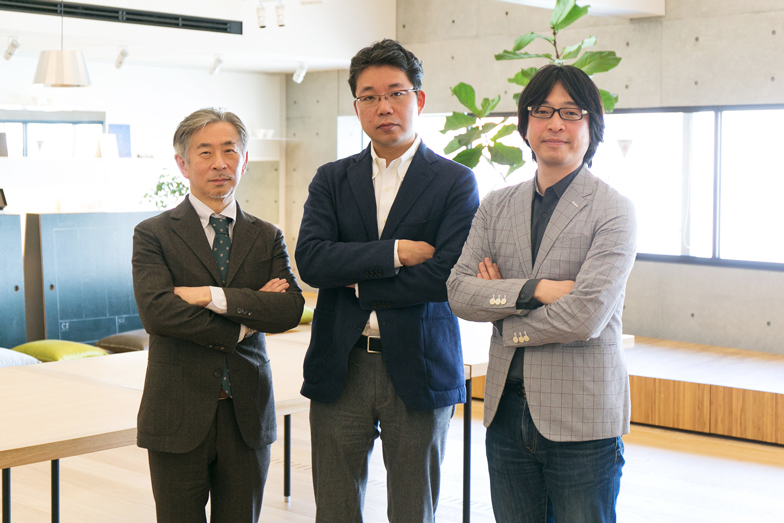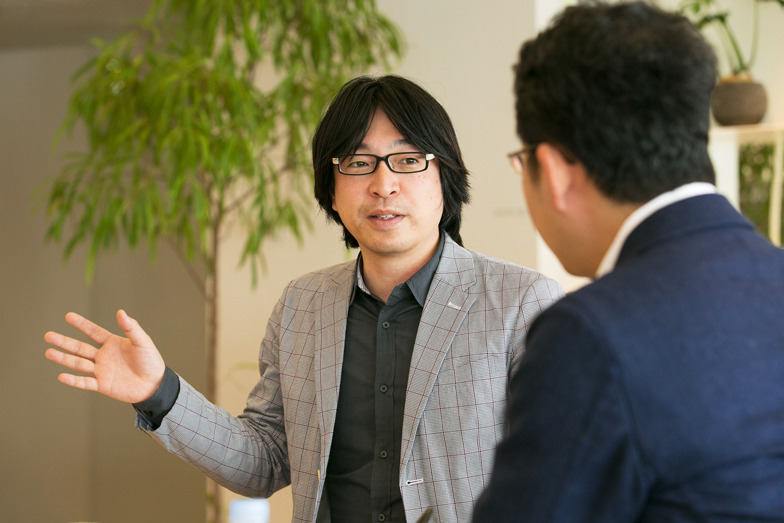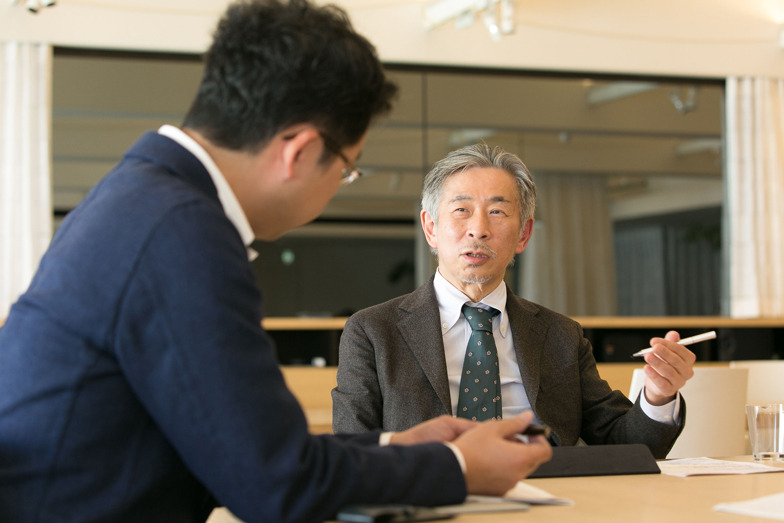"Co-Creation" refers to an approach where new value is generated through dialogue with diverse stakeholders. Derived from the meaning of "creating together," it is also called "kyōsō" (共創). The co-creation portal site "cotas," operated by Dentsu Inc. and Infobahn, held the third "Japan Co-Creation Awards 2014" to honor outstanding examples of co-creation. This series explores co-creation trends and movements through the winning cases and the judges' perspectives.
This time, three individuals—Mr. Noboru Konno, an award judge and representative of KIRO (Knowledge Innovation Research Organization); Mr. Ryusuke Koyama, whose 'Hack Series' including 'IDEA HACKS!' is widely supported by business professionals; and Mr. Hirokazu Tanaka of Dentsu Inc.—engaged in a wide-ranging discussion. They explored themes such as the nature of workshops, scenario planning, and design thinking, occasionally touching on the hippie movement and Zen philosophy.

Can workshops create future scenarios?
Tanaka: As this is the final session of the "Co-Creation 2015" series, I'd like to focus on the "future" created through co-creation. In today's corporate management, business, and marketing, the importance of envisioning the future is growing ever greater. Yet, at the same time, predicting the future is becoming increasingly difficult. Could co-creation be the solution?
Konno: Co-creation is a means to generate value, not an end in itself. The key is how to drive activities that create previously unseen value. To achieve this, establishing a "space" for sustained transformation is crucial. We often hear stories like, "We held a workshop, and it was really exciting at the time, but then nothing happened afterward..." Several years ago, we launched the "Future Center Research Group" precisely because of this concern. Co-creation isn't just about holding workshops to talk about the "future"; it's about actually co-creating the future.
For example, traditional "scenario planning" was largely a passive tool for "preparing for what might happen" or generating ideas. Today, however, we need active, practical scenario planning that engages stakeholders on the ground, debates pros and cons, and transforms complex situations.
Tanaka: Future forecasting involves two perspectives: "How to respond to environmental changes?" and "How to proactively shape environmental changes ourselves?" I recall a project for a foreign company where we had a competitive presentation on future forecasting. The client had already developed a solid base scenario themselves. What they asked us to do was to come up with hypotheses that deviated from it. In other words, the purpose was to "generate many unconventional ideas that the client hadn't thought of." However, in the end, none of the proposals, including those from Dentsu Inc., were adopted. I remember being deeply impressed at the time by how seriously the client was considering how to respond to environmental changes.
Konno: The fact that "none were adopted" probably means each company's proposal was quite similar. That's very interesting. When you base your thinking on the given information, the results tend to be nearly identical no matter who does the thinking. In fact, scenario planning is based on the premise that predicting the future is impossible. To change the situation from there, the purpose – "what you want to achieve" – and subjectivity are crucial. It's not just about vaguely "discussing the future of XX." When you create scenarios with a purpose, you get creative scenarios that can only emerge from that specific situation, rather than generic, objective ones.
Tanaka: So intentional deviation is key.
Konno: If you create scenarios solely through workshops, you'll end up with nearly identical results. However, when you actually go to the field and engage in deep, relationship-based dialogue around challenges—like asking, "We need to accomplish this by such-and-such a date. What do you think?"—interesting scenarios emerge.
Tanaka: Responding to environmental changes is important, but right now, the visionaries who are pioneering business are the ones thinking about "how to create environmental change." Moreover, many of these people were influenced by the hippie movement in the 70s. I feel there's a significant historical trend and hint here. Mr. Koyama also has a background in hacker knowledge and a deep understanding of subcultures, including hippies.
Koyama: If you trace hippies back, you arrive at Eastern philosophy. It's the idea of non-separation between subject and object, where you don't separate yourself from the environment. This philosophical current has persisted. For example, mindfulness (meditation) is a new keyword today. When generating ideas or driving innovation, this relationship with the environment becomes crucial. And when you become one with the environment, what emerges is an intuition about how the future will unfold. You then become aware of your own role in that future.
The late Steve Jobs' thinking and actions exemplified this perfectly. When conducting scenario planning, it's vital whether an intuitive image of the future emerges. It must contain this sense of agency – "Because this is the future, I want to commit to this" – rather than being an analytically derived conclusion. However, so-called workshop-style approaches often conceal the question, "So, what will you do?" If asked that directly, no one would participate in the workshop.

Tanaka: As a Japanese person, it feels a bit embarrassing, doesn't it?
Koyama: It should be a set: first, intuitively envisioning the future, then consciously deciding how you will engage with that future, and the accompanying decision. What's truly crucial in scenario planning today isn't predicting the future, but the urgent question: "Given this future, what decision will you make now?" This involves self-transformation, not changing the future environment. You need to let go of preconceptions about the future and accept both the new future and your own decision. What the hippies did was also about changing their decisions and transforming themselves by experiencing the future through meditation and similar practices. True scenario planning is about doing what it takes for yourself to change, for your company to change.
Furthermore, when technology connected with this hippie culture, it gave birth to hacker culture. Hacking, however, is never a conceptual endeavor; it's partial and ad hoc. It's not about declaring, "We have this grand design, so let's all do this!" It started as pranks, aiming to change specific parts using technology. Yet what's fascinating is the decisions and actions achievable by a single individual, actively engaging with their environment. And this brings significant, undeniable impact to the world.
Tanaka: I see. My "Hirokazu Tanaka Movement," where I search for people with the same name and have met 103 Hirokazu Tanakas so far, could also be called a name hack. It's a playful exploration of what happens when you hack a name.
Koyama: One reason I write books on life hacks is that individuals can sometimes feel powerless when engaging with the world. But just by slightly changing how you interact with your surroundings, you change yourself, and the world gradually changes too. It's certainly not a total solution, but I want to convey this image: that each person changing little by little can transform the whole. It's about hacking – not just following the rules, but deviating from them to glimpse a new future.
Intentionally creating deviations
Tanaka: The other day, I took my seven-year-old daughter to the teamLab exhibition at the National Museum of Emerging Science and Innovation. They recreated the world of Japanese painting through digital art and turned it into interactive art. What they highlighted there was the issue of world perception. They argued that the flatness of Japanese fusuma paintings reflects how Japanese people actually perceived the world – not through Western perspective, but as art that depicts space on a flat plane where the subject and the setting appear as one.
Another piece proposed a "new amusement park" through interactive art, where many children were playing. They were actively engaging with the environment, constantly changing the paintings, or seeing fish they drew swim out into a giant aquarium. That form truly expressed what Mr. Koyama mentioned—a new Japanese way of perceiving the world and interacting with it. I thought it was a very contemporary exhibition.
Koyama: The way they step beyond the role of spectator into the creator's domain is truly hack-like. What's interesting is that the children's creations aim for deviation. Even when drawing fish, they draw something fish-like yet not quite a fish. The children deviate from the rule of "this is what a fish is." They embrace this deviation because play is a continuous series of deviations. From that deviation, the environment changes, generating further new deviations.
Konno: This bears similarities to the currently popular "design thinking." Rather than deducing and analyzing everything from the start, you first formulate hypotheses based on small changes or insights in the current situation and then prototype. Especially in highly uncertain situations, planning-based approaches have already failed. Change happens when someone actually tries something. As the situation changes, perspectives shift. This deepens insights, leading to further prototyping. I believe the framework for understanding the world has shifted over the past 50 years or so, starting with the hippie movement and the emergence of the hacker generation. It finally feels like this shift is entering the business world too.

Koyama: History itself can shift dramatically due to the chance emergence of a single individual. You can't possibly plan for every single thing. You could make a plan that misses the mark 100%, sure (laughs).
Konno: Today's discussion venue, "NADoffice" (http://www.nikken.co.jp/ja/nad/), is a new initiative by Nikken Sekkei. Even in urban planning, so-called planning-centric approaches are being questioned. There's a growing movement toward co-creation—building together with citizens and users. The background for creating NADoffice was the realization that we, too, must break away from the traditional design firm world.
Tanaka: Last year, the nonfiction book "Unreasonable Evolution" became a hot topic. What I found fascinating was the fact that 99.9% of all species have gone extinct. We tend to view evolution as if it had a purpose, but intentional evolution doesn't exist in nature. It happens by chance, and the phenomenon of survival of the fittest remains as a result. I found it incredibly interesting to read that evolution inherently involves contingency. When we hear about change, we tend to assume there's a rational purpose behind it, but nature never operates that way.
Konno: 99.9% don't survive, but 0.1% of species do. If this is evolution, then rather than desperately strategizing about innovation, trying many things is what makes you strong. That's why Silicon Valley is strong. Silicon Valley is called the graveyard of ideas; 99.9% of ideas vanish. It's an environment where many ideas disappear, but it's also an environment where ideas can be resurrected. Perhaps having such a place is what enables evolution.
Tanaka: It really makes me realize anew how remarkable it is that there exists a place capable of truly embracing richness—or diversity—and that people gather there.
Konno: You absolutely won't see anything new if you only rely on your own company's logic. Discussing with diverse people gives you new perspectives. Intentionally "designing deviation" is becoming increasingly important.
Tanaka: The current situation might be that maintaining the status quo only leads to shrinking reproduction, leaving no room for added value to emerge.
Koyama: When trying to create such a space, the hardest part is being asked, "How much profit will this generate?" – that direct demand for a causal relationship. There are two kinds of causality: the directly recognizable "cause and effect," and the indirectly connected, what Buddhism calls "dependent origination" (enki). It's the kind of "bad karma" you hear about. It's not directly related, but there's a sense of connection somewhere.
This "dependent origination" is like when a seed sprouts: "The seed exists, so the sprout emerges" is direct causality. But for that to happen, it needs moderate warmth, water, and of course, soil. Without these, the seed won't sprout. These various conditions and complex relationships are the "conditions" (en).
In that sense, a place like NADoffice is a place of auspicious connections that fosters these relationships. A seed that didn't sprout within a company might sprout here. The use of biological metaphors like "incubator" or "hatching" is symbolic. Innovation deals precisely with something vital that won't sprout without these connections.
Tanaka: Today, across various business contexts, there's a growing demand for how to cultivate "縁."
Koyama: In that sense, advertising agencies don't deal with "causality." What they manage is the management of "auspicious connections" – the connection between the client and the product. You could also say they cultivate the soil that nurtures these connections.
Tanaka: I once heard someone from a TV station say, "We are in the mood industry." I think advertising operates precisely within this realm of mood management.









